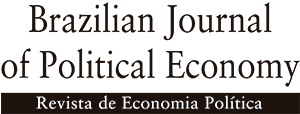This article aims to analyse the evolution of the corporate banking credit market in Brazil during the recent cycle (january 2003 to june 2009) from a Keynesian theoretical reference point. The article focuses on the dynamics of the six major segments of this market (industry, commerce, services, infrastructure, real estate and rural sector), highlighting their main similarities and differences concerning the cyclical dynamics, the participation in the total corporate banking credit, the origin of resources, the composition of capital ownership and the performance of public and private banks.
banking credit; Brazilian economy; Keynesian theory







